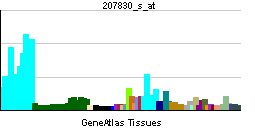PPP1R8
| Inhibidor nuclear de la fosfatasa 1 | ||||
|---|---|---|---|---|
 Estructura tridimensional de la proteína PPP1R8. | ||||
| Estructuras disponibles | ||||
| PDB |
Lista de códigos PDB 2jpe
| |||
| Identificadores | ||||
| Símbolos | PPP1R8 (HGNC: 9296) ARD1; ARD-1; NIPP-1; NIPP1; PRO2047 | |||
| Identificadores externos | ||||
| Locus | Cr. 1 p35.3 | |||
| Patrón de expresión de ARNm | ||||
 | ||||
| Más información | ||||
| Ortólogos | ||||
| Especies |
| |||
| Entrez |
| |||
| Ensembl |
| |||
| UniProt |
| |||
| RefSeq (ARNm) |
| |||
| RefSeq (proteína) NCBI |
| |||
| Ubicación (UCSC) |
| |||
| PubMed (Búsqueda) |
| |||
El inhibidor nuclear de la fosfatasa 1 (PPP1R8) es una enzima codificada en humanos por el gen PPP1R8.[1][2][3]
Este gen, por medio de splicing alternativo, codifica tres diferentes isoformas. Dos de ellas son inhibidores específicos de tipo 1 serina/treonina fosfatasa y pueden unir, pero no romper el [ARN]]. La tercera isoforma no posee la función inhibidora fosfatasa, pero es una endorribonucleasa de hebra sencilla semejante a la ARNasa E de Escherichia coli. Esta isoforma requiere magnesio para su función y rompe específicamente regiones del ARN ricas en A+U.[3]
Interacciones
[editar]La proteína PPP1R8 ha demostrado ser capaz de interaccionar con:
Referencias
[editar]- ↑ Wang M, Cohen SN (Nov de 1994). «ard-1: a human gene that reverses the effects of temperature-sensitive and deletion mutations in the Escherichia coli rne gene and encodes an activity producing RNase E-like cleavages». Proc Natl Acad Sci U S A 91 (22): 10591-5. PMC 45067. PMID 7524097.
- ↑ Mishima K, Tsuchiya M, Nightingale MS, Moss J, Vaughan M (mayo de 1993). «ARD 1, a 64-kDa guanine nucleotide-binding protein with a carboxyl-terminal ADP-ribosylation factor domain». J Biol Chem 268 (12): 8801-7. PMID 8473324.
- ↑ a b «Entrez Gene: PPP1R8 protein phosphatase 1, regulatory (inhibitor) subunit 8».
- ↑ a b c Jin, Qiming; van Eynde Aleyde, Beullens Monique, Roy Nivedita, Thiel Gerald, Stalmans Willy, Bollen Mathieu (Aug. de 2003). «The protein phosphatase-1 (PP1) regulator, nuclear inhibitor of PP1 (NIPP1), interacts with the polycomb group protein, embryonic ectoderm development (EED), and functions as a transcriptional repressor». J. Biol. Chem. (United States) 278 (33): 30677-85. ISSN 0021-9258. PMID 12788942. doi:10.1074/jbc.M302273200.
- ↑ Ajuh, P M; Browne G J, Hawkes N A, Cohen P T, Roberts S G, Lamond A I (Feb. de 2000). «Association of a protein phosphatase 1 activity with the human factor C1 (HCF) complex». Nucleic Acids Res. (ENGLAND) 28 (3): 678-86. PMID 10637318.
- ↑ Boudrez, An; Beullens Monique, Waelkens Etienne, Stalmans Willy, Bollen Mathieu (Aug. de 2002). «Phosphorylation-dependent interaction between the splicing factors SAP155 and NIPP1». J. Biol. Chem. (United States) 277 (35): 31834-41. ISSN 0021-9258. PMID 12105215. doi:10.1074/jbc.M204427200.